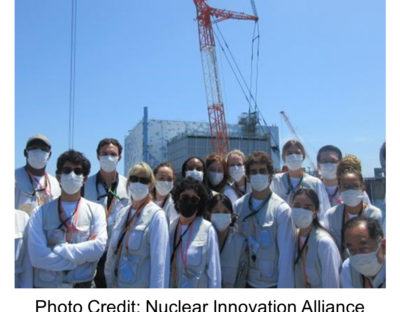 “We have to solve baseload power, ” quipped Bill Nye (the Science Guy) in his speech at the Aspen Ideas: Climate in March. This challenge stuck with me throughout his talk, which centered on clean power’s immense benefits, while frequently returning to the major shortfall of cheap solar and wind: intermittency. Forecasted or not, power irregularity is an expensive problem to manage. Reducing intermittency on our electric grid, whether it be caused by an unforeseen natural disaster or the regular cycle of solar power, should be a priority.
“We have to solve baseload power, ” quipped Bill Nye (the Science Guy) in his speech at the Aspen Ideas: Climate in March. This challenge stuck with me throughout his talk, which centered on clean power’s immense benefits, while frequently returning to the major shortfall of cheap solar and wind: intermittency. Forecasted or not, power irregularity is an expensive problem to manage. Reducing intermittency on our electric grid, whether it be caused by an unforeseen natural disaster or the regular cycle of solar power, should be a priority.
Upon returning home from the Institute’s Future Leaders Climate Summit, I turned to a nearby source of power to better understand the source of clean, baseload power in my community: southeastern Virginia’s Surry Nuclear Power Plant (SNPP). It is so nearby that the City of Williamsburg, where I call home, is the only locality to fall entirely within SNPP’s 10-mile radius fallout zone of nuclear meltdown danger. It was not hard to feel a vested interest.
Over the next few months, not only did I visit SNPP, but I pursued my curiosity more formally through participation in the Nuclear Innovation Bootcamp. In August 2023, our class spent two weeks in Japan studying the future of atomic power at the Tokyo Institute of Technology. Nuclear energy is a rare clean energy that has both fervent supporters and detractors. With its high-risk nature, implementation must be deliberately planned. In this article, I reflect on three areas of this innovating industry: maintaining legacy power plants, advancements in reactor design, and the changing public perception of atomic power. I also conclude with easy ways to engage for anyone curious about this clean technology.
1. Maintaining Legacy Power Plants
Existing nuclear power accounts for 20% of all electricity generation in the United States today. With 54 nuclear power plants (NPPs) in 28 states, our legacy reactors rival the energy production of coal and vastly outpace other sources of clean power (though shrinking costs are thankfully causing a rapid adoption of solar PV). The average age of these reactors is 42 years and many are reaching the end of their initially-permitted period of 40 years, which was originally determined for “economic and antitrust considerations – not on limitations of nuclear technology.”
It is imperative that existing reactors be re-permitted to maintain the country’s usage of fossil-free power. While nuclear power will likely make up a minority of our entire clean energy production capability, it is critical to preserve existing carbon-free resources. Using my nearby Surry Nuclear Power Plant as an example, Virginia’s usage of atomic power accounts for over 90% of our clean energy production. The SNPP was recently granted a license extension of 20 years, but the re-permitting process has been more contested elsewhere, like Diablo Canyon. This fight against Diable Canyon comes from a valid place of concern, with local residents questioning the storage of nuclear waste and safe lifetime of the facility. It is important to temper concerns about existing nuclear plants with what power supply could replace them in the energy stack. Should original permits lapse en masse, not only will decades of productive lifespan be wasted, but the resulting compensation of fossil fuels to backfill local energy demand would bring negative externalities.
2. Advancements in Reactor Design
Intermixed into considering historic challenges, the Nuclear Innovation Bootcamp (NIB) also focused on the next generation of atomic power, or advanced nuclear reactors (ANRs). These reactors are intended to be smaller, cheaper, and capable of mass-manufacturing. Unlike legacy reactors, which average at a generation of 1 gigawatt, ANRs can range from 300 megawatts to as little as 100 kilowatts. Design standardization attempts to make ANRs more deployable for public and private sector use (for instance, Dow Chemical has announced this demonstration project). On top of their turnkey timeline, ANRs are also safer to the public. As one of the few ANR manufacturers in the world, Westinghouse is actively installing passively-secured nuclear systems. Its AP1000 design has four units currently operating in China, with another six under construction. This design utilizes “the natural forces – gravity, natural circulation and compressed gasses – to keep the core and the containment from overheating.” 
Along with advancements in reactor safety, the NIB challenged participants to respond to significant investment in ANRs with a business pitch of our own. Pictured here is the ideation phase of our Bootcamp, where teams formed around ideas to promote the next generation of nuclear energy. Participants pursued ideas ranging from supplying specialized uranium fuel to job readiness training. Given the plethora of ANR designs, it also became apparent that the nuclear industry’s need now is not new reactors but the conjoining business infrastructure of supply chain vendors, regulatory advising, and more.
3. Changing Public Perception of Atomic Power
Finally, the nuclear industry’s largest historical setbacks have been fallouts in public opinion in the aftermath of major disasters. These disasters, including Three Mile Island (1979), Chernobyl (1986), and Fukushima (2011), halted the industry’s growth, irrevocably in some countries. In the United States, 40 years passed before we completed construction of a new nuclear facility, Plant Vogtle, this year. To better grasp what disaster looks like, our Bootcamp visited the Fukushima Daiichi Nuclear Power Plant, with the decommissioning of Unit 2 .
.
This was a stark reminder of historic safety failures that retrofitting existing reactors and adopting passive safety features in ANRs will mitigate. As exemplified by Diablo Canyon, existing sentiment against atomic power could lead to direct reductions in fossil-free energy. Much of this negative sentiment has also been shaped by the few high-profile fiascos over the last 40 years, yet nuclear energy by terawatt-year has actually earned the highest safety reputation.
A broader review of nuclear energy’s safety, mixed with our heightened demand for fossil-free power, has led to my final area of focus: public perception. Whether it be Oliver Stone’s Nuclear Now documentary or bipartisan support for a domestic uranium supply, the growing support for nuclear power is invigorating. On a personal note, I left Tokyo greatly encouraged by my fellow participants in the Nuclear Innovation Bootcamp. These other 30 young people were also at the beginning of their careers and curious how they could positively impact the field. This year was notably the first time the NIB had equal representation between men and women, and our group (pictured here) represented 16 different countries.
Now let us talk about what one can do: educate and advocate. To first educate, the continuation of a nuclear energy self-study can be best begun at easily-accessible Spotify Podcasts. Titans of Nuclear conducts interviews with industry leaders and World Nuclear News is quickest with world-wide reactor updates. There are also a number of nuclear advocates active on X, such as @isodope, @nuclearhazelnut (my NIB classmate!), and @grace_stanke (did you know Miss America 2023 is a nuclear energy superfan?). These leading women are engineers and influencers wrapped into one, providing sources of cogent (and fun) nuclear energy information.
For those in the U.S., state-level advocacy is critical to maintain our country’s current 20% stack of clean, nuclear energy. After the Three Mile Island incident of 1979, many state legislatures echoed the concern of their constituents to pass moratoriums on new nuclear energy (such as Oregon). While this was a fair reaction of the time, these moratoriums still exist today. These 12 states continue to ban nuclear power. Since 2016, five states have repealed or allowed exemptions around their moratoriums. One powerful way to engage in the good of nuclear energy is continuing this trend of repeal, especially in our populous states of California and New York. By finding your state-level representatives, you can start supporting maintaining legacy nuclear reactors today. I would also be remiss to not encourage those interested in learning more to apply to the Nuclear Innovation Bootcamp of 2024! The application is here and it is open until February 25th.
Exploring Bill Nye’s baseload power challenge taught me a great deal about atomic power’s place in our electric grid of tomorrow. Addressing the intermittency issue in clean power is crucial and, as highlighted through the lens of Surry Nuclear Power Plant and the Nuclear Innovation Bootcamp, there are promising avenues. From re-permitting legacy power plants to advancing smaller and safer reactors, and a positive shift in public perception, we are on a hopeful trajectory towards a cleaner and more reliable energy future.
Caleb is a City Councilor in Williamsburg, Virginia. In his final semester, Caleb campaigned for and won a seat on the Council to bring a younger perspective. Having started his term in 2020, Caleb has worked to increase affordable housing options and adopt a Climate Action Plan. Caleb also works in business development at an industry-leading clean technology company. Voltus pays North American C&I energy consumers to shift electricity use in response to grid stress and high emissions. Caleb is a 2023 Aspen Institute Future Climate Leader.

